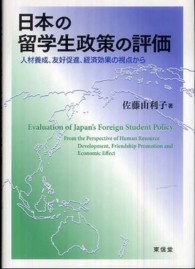- ホーム
- > 洋書
- > 英文書
- > Psychology
Full Description
This work explores the function of both divisive and uniting symbols in various conflict settings around the world. It takes a fairly broad perspective on what constitutes a symbol, to include objects such as flags, signs, language, and monuments, all of which convey conflicting meanings in a society affected by conflict. In addition, the authors include commemorations and other dynamic events that serve as a means for groups or individuals to connect with past generations, celebrate a heritage, and possibly express religiosity. In order to provide context for the nuances surrounding the symbols, there are brief historical overviews for each conflict featured in the volume. In each chapter, three issues are emphasized: the particular symbols that are divisive in the specific culture; how these symbols were used to perpetuate conflict; and how these symbols can be used or modified to bring unification. Contributions come from authors from around the world that have conducted empirical studies on intergroup relationships or have provided significant academic contributions in the area of symbols and collective memories represented in theoretical publications.
Taken together, the contents of the volume provide a rich tapestry of intellectual analyses to the diverse selection of conflict settings from around the globe. In addition to the nine case studies, there is an introductory chapter, which grounds the discussion in current peace psychology literature as well as provides future directions. This volume is a valuable resource to many, as the focus on symbols can span many disciplines such as political science, anthropology, sociology, psychology, and art. Furthermore, it is of significant interest to all scholars and peace activists studying these various countries and their conflicts.
Contents
Preface.- Chapter 1.The Functions of Symbols that Divide and Unite by Rebekah Phillips DeZalia and Scott Moeschberge.- Chapter 2. Forsaken Monuments and Social Change: The Function of Socialist Monuments in the Post-Yugoslav Space by Sandina Begić and Boriša Mraović.- Chapter 3. "What We Are, Where We Are Headed": A Peace March Visits and Ex-Torture Center by Carolina Muñoz Proto.- Chapter 4.Contested Symbols as Social Representations: The Case of Cyprus by Charis Psaltis, Tahir Beydola, Giorgos FIlippou and Nekatios Vrachimis.- Chapter 5.Symbols that Speak: Christ and His Word in El Salvador by Jose Leonardo Santos.- Chapter 6.Holocaust Collective Memory in the Context of the Palestinian-Israeli Conflict: A Multifaceted Symbol by Cristina Adriani.- Chapter 7.Understanding Symbols of Division in Post Conflict Northern Ireland by Maurice Stringer and Jackie Hunter.- Chapter 8.Social Representations in Post-Genocide Rwanda by Rebekah Phillips DeZalia.- Chapter 9.Post-Apartheid South Africa: A United or a Divided Nation? By Elirea Bornman.- Chapter 10.Heritage or Hatred: The Confederate Battle Flag and Current Race Relations in the United States by Scott L. Moeschberger.




